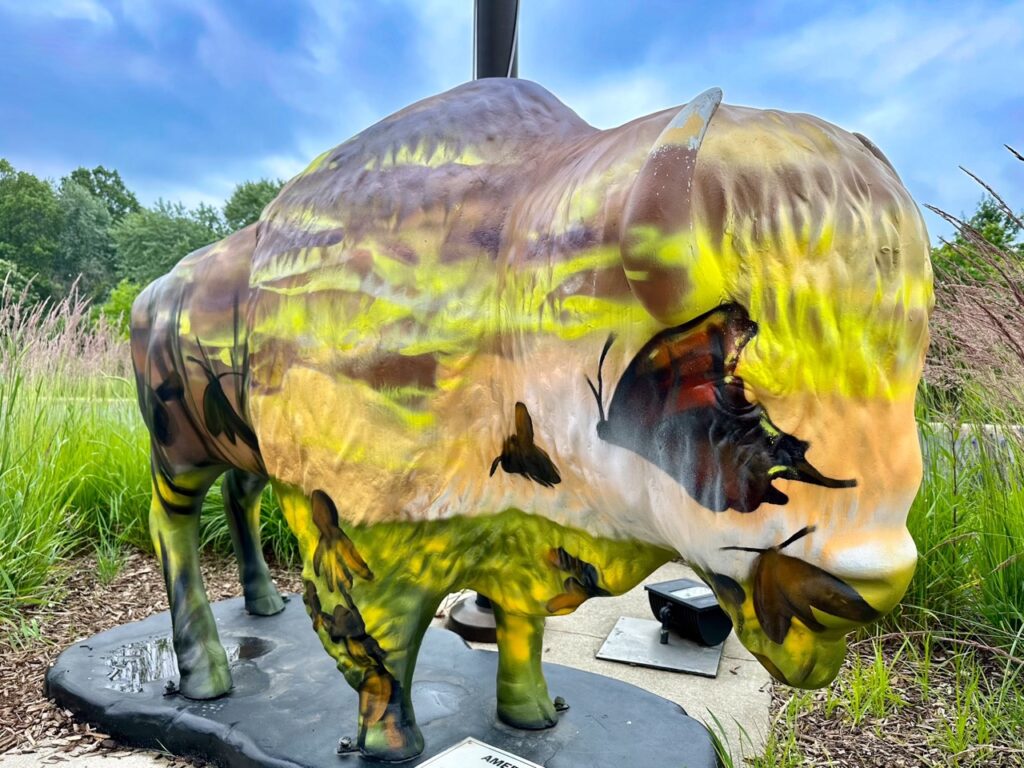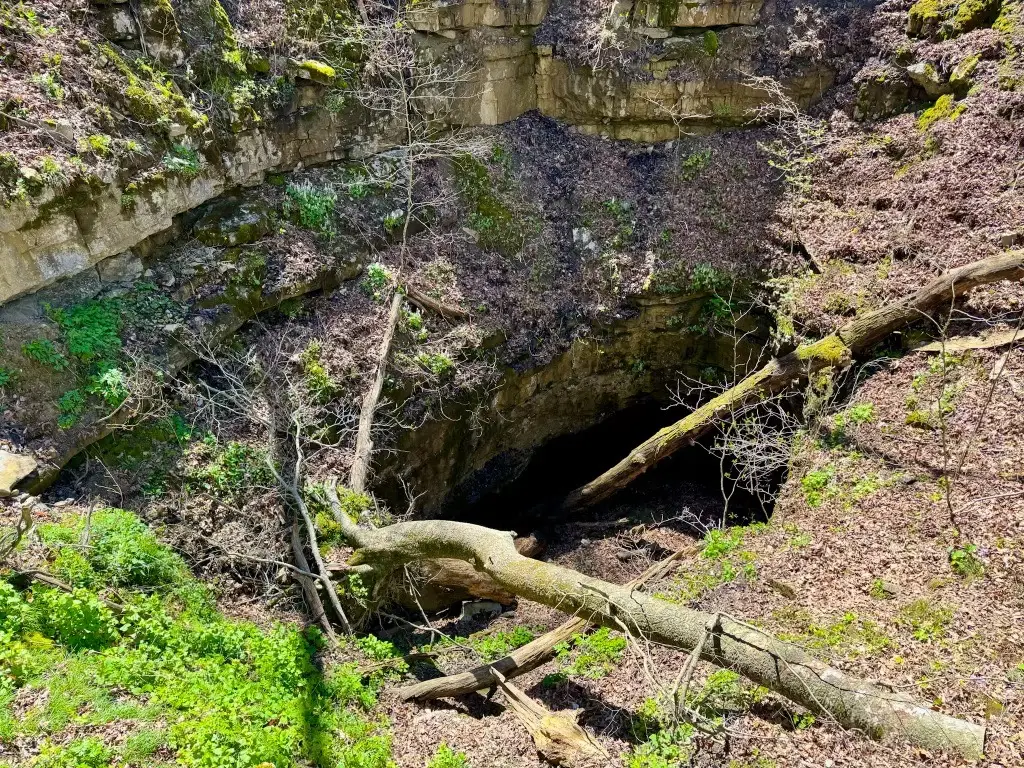6 dog-friendly National Parks that are great for hiking
Dogs are family and family adventures are the best kind! Many National Parks are dog-friendly, but only allow dogs on a couple select trails. The six included included in this post are some of the least restrictive in terms of where your dog can hike within the park’s boundaries. In fact, they welcome and encourage furry friends to enjoy the park’s hiking trails alongside you.
This site contains affiliate links, which means when you click, we may receive a small commission from your purchase at no additional cost to you. This helps us run this page and offer great content free of charge, and we only recommend products that we use and love. We appreciate you!

Why many National Parks strictly regulate dogs
Most national parks are not dog-friendly due to concerns for wildlife, ecosystems, and visitor safety. Dogs can disturb or harass wildlife, spread diseases, and damage fragile environments. They also pose risks to other visitors, especially in busy or hazardous areas. While some parks allow pets in designated areas or on specific trails, the overall restriction is to protect both animals and the natural landscape, ensuring a safe and enjoyable experience for all.
But the parks included in this post do allow and even encourage dogs to hike their trails, which makes them some of our favorites!
BARK Ranger Programs at National Parks
We first discovered the whole BARK Ranger phenomenon while waiting out a storm at Pecos National Historical Park. A ranger spotted us, asked us if we were BARK Rangers, and when we had no idea what he was talking about, he opened the door to a whole new world! He recited the BARK Ranger principles with us, and then presented Bonnie & Ada with collectible tags, specific to Pecos. It was adorable, and super sweet! And we have not stopped chasing BARK Ranger Parks since.
BARK Ranger programs only exist at some National Parks, and there is a lot of diversity park-to-park in terms of what their programs entail. The common thread is the principles (below), which a ranger will always review with you when you ask about the program. Sometimes there are activities to complete with your dog. Sometimes you are simply given a piece of paper that lists the principles. Sometimes they will gift you a special tag, and sometimes they will direct you to the gift shop where you can buy a tag. Some parks have other special BARK Ranger merch – Bryce Canyon has BARK Ranger patches for sale, while Hot Springs has an array of different BARK Ranger Bandanas, dog toys, and other little goodies in their gift shop. Indiana Dunes has tags for sale, but will give you a bandana for free when you ask a ranger.
The bottom line is that participating parks differ because it’s basically just up to a staff member to create the BARK Ranger program they want to see in their park. So a good rule of thumb is to simply always find a ranger and ask:
- Do you have a BARK Ranger program at this park?
- I have a dog who would like to be a BARK Ranger – What’s involved?
- Do you gift BARK Ranger tags or other merch? Or do you have some for purchase in the gift shop?

BARK Ranger Principles
- Bag your pets’ waste. Help keep your national park clean by collecting and disposing of all dog waste. Public garbage cans are located throughout the park, including at the visitor center.
- Always keep your pet on a leash. For the safety and comfort of all the park’s visitors, dogs must be restrained on a leash no longer than 6 feet. We know that sometimes Fido likes to run free, but keeping dogs on leashes will also protect them from ticks, snakes and other wildlife, and other dogs.
- Respect wildlife. The park is also home to snakes, birds, rabbits, deer, and other wildlife. Pets can harass or harm wildlife by making noise or scaring wildlife away. Please keep your dog at a respectful distance from any animals you may encounter.
- Know where you can go. Pets are not allowed inside park facilities, including the visitor center. However, the national park is home to 26 miles of trails that dogs (and their humans) love!
The Dog-Friendly Parks
Related Post: Guide to visiting National Parks with your dog (Even the least dog-friendly ones)
1. Great Sand Dunes National Park, Colorado
BARK Ranger Program: YES

The Great Sand Dunes were formed through a complex combination of geological and environmental forces. The uplift of surrounding mountain ranges created the San Luis Valley, where ancient lakes once deposited sand. As the lakes receded, winds and seasonal storms sculpted the sand into towering dunes, with the area’s unique geography funneling the sand into its current configuration. The seasonal streams, like Medano and Sand Creeks, continue to reshape the dunes, preventing them from advancing into the mountains. This ongoing natural process has produced the tallest sand dunes in North America.
The park is home to a diverse array of wildlife adapted to its extreme environment. Amphibians such as tiger salamanders and chorus frogs have developed the ability to freeze during winter and return to life in the spring. Other species, including northern leopard frogs and spadefoots, thrive in the park’s wetlands and dunes. Among the mammals, Ord’s kangaroo rats live in the dunefield year-round, using the sand for shelter and moisture. Over 250 bird species, including iconic sandhill cranes, are found in the park, making it an important migration stop. The park’s ecosystems range from alpine tundra to wetlands, providing habitats for a wide variety of species in this unique, high-altitude desert landscape.
🐾Dogs are allowed on many trails & dunes, but are prohibited from wilderness areas. Check the park’s website for specific inclusions/exclusions.
Pet Policies at Great Sand Dunes National Park
Why we love Great Sand Dunes
Great Sand Dunes National Park is truly spectacular! I’ve lived in Colorado for many years, and until a few years ago, only drove past this park and marveled from afar. After we adopted Bonnie and Ada, I resolved to get to all of Colorado’s parks, and this was top of our list!
Miles of sandy terrain means endless opportunities for dogs to dig, run, bounce, and climb. This is one of the least restrictive national parks in the US for dogs, and it’s a true gift. The park looks beautiful under a blanket of fresh snow, so it’s ideal to visit in winter. But it truly comes alive when Medano Creek gushes down from snow melt in the early summer, creating a beachy atmosphere in the park. You’ll probably want to avoid visiting in high summer, because sand temperatures get really high. But evening and early morning visits are fine if this is the only time you can make it.
In addition to climbing and hiking around the dunes, the park also includes mountain trails that your dog is welcome to hike. In short, this park is a complete dog-friendly paradise year-round, and I promise you will be completely blown away by the beauty.
Our favorite dog-friendly hiking trails
2. White Sands National Park, New Mexico
BARK Ranger Program: YES

White Sands National Park, known for its stunning gypsum dunes, showcases millions of years of geological evolution. Over 250 million years ago, gypsum was deposited in the Permian Sea, and through tectonic shifts and climatic changes, the Tularosa Basin formed, eventually giving rise to the white sand dunes seen today. These dunes are continually reshaped by wind and erosion, creating a dynamic landscape. Over time, many animal species adapted to the white environment, evolving lighter colors to blend into the dunes, providing a survival advantage.
The park is home to more than 800 species, including several unique to the area. Notable residents include the light-colored Apache pocket mouse, bleached earless lizard, sand-treader camel cricket, and sand wolf spider. The park also hosts a remarkable variety of endemic moths—about 40 species—that have evolved to thrive in the gypsum-rich environment. These animals, many nocturnal, have developed specialized survival strategies for the harsh conditions, making White Sands a fascinating example of evolution in action.
White Sands National Park, known for its stunning gypsum dunes, showcases millions of years of geological evolution. Over 250 million years ago, gypsum was deposited in the Permian Sea, and through tectonic shifts and climatic changes, the Tularosa Basin formed, eventually giving rise to the white sand dunes seen today. These dunes are continually reshaped by wind and erosion, creating a dynamic landscape. Over time, many animal species adapted to the white environment, evolving lighter colors to blend into the dunes, providing a survival advantage.
The park is home to more than 800 species, including several unique to the area. Notable residents include the light-colored Apache pocket mouse, bleached earless lizard, sand-treader camel cricket, and sand wolf spider. The park also hosts a remarkable variety of endemic moths—about 40 species—that have evolved to thrive in the gypsum-rich environment. These animals, many nocturnal, have developed specialized survival strategies for the harsh conditions, making White Sands a fascinating example of evolution in action.
🐾Dogs are allowed on ALL trails & dunes in the park, but check the park’s website for specific considerations.
Pet Policies at White Sands National Park
Why we love White Sands
White Sands is truly incredible. This park transports you to a place so unlike anything else in this world, you can’t help but stand in awe. Much like the Great Sand Dunes, this park has miles and miles of sand dunes for you and your dog to explore by climbing, sliding, digging, running, bounding, and rolling. The possibilities are endless.
We suggest planning your trip so you catch a sunset, because the light bouncing off the white sand is like nothing I’ve ever seen before! This is another great park to visit in the winter time, to avoid extreme heat, but it is truly beautiful year-round as long as you plan ahead and be conscientious about your dog’s needs.
Our favorite dog-friendly hiking trails
3. Petrified Forest National Park, Arizona
BARK Ranger Program: YES
Petrified Forest National Park, located on the southern edge of the Colorado Plateau, showcases a vibrant interplay of ancient history and modern ecosystems. The park features colorful badlands of bentonite clay, mesas, buttes, and the fossilized remains of a Late Triassic floodplain, including its iconic petrified wood. These striking geological features are shaped by erosion and capped by sandstone, preserving the story of an ancient environment. Today, the park’s grasslands, shrublands, and riparian zones support diverse wildlife and plants, connecting the past with the present in a dynamic landscape that continues to evolve.
🐾Dogs are allowed on ALL trails and wilderness areas in the park, but check the park’s website for specific considerations.
Petrified Forest National Park Pet Policies
Why we love Petrified Forest
Petrified Forest National Park is the only one on this list that we have yet to visit, but it’s on our list for next year. So I can’t offer personal perspectives aside from the fact that they’re well known as one of the most dog-friendly parks in the country, and I’ve heard it’s absolutely stunning!
Top recommended dog-friendly hiking trails
- Historic Blue Forest Trail
- Blue Mesa Trail
- Old Jasper Forest Road
- Crystal Forest Trail
- Painted Desert Rim Trail
- Long Logs and Agate House Loop Trail
- Onyx Bridge Trail
- Giant Logs Trail
4. Indiana Dunes National Park, Indiana
BARK Ranger Program: YES

Indiana Dunes National Park, located at the southern tip of Lake Michigan, is a rich mosaic of ecosystems, spanning over 15,000 acres of diverse habitats including sand dunes, oak savannas, wetlands, prairies, and forests. The park preserves a unique record of glacial history, with dunes and shorelines formed as the Wisconsin Glacier retreated 14,000 years ago. These features support over 1,100 plant species and a remarkable variety of wildlife, including 350 bird species that rely on the park during migration.
Due to its position at several ecological transition zones, the park is one of the most biologically diverse national parks, ranking fourth in diversity despite its small size. Its range of habitats, coupled with the moderating influence of Lake Michigan, provides shelter for a wide array of species, including 46 mammals, 18 amphibians, 71 fish species, and the federally endangered Karner blue butterfly. The park’s diverse ecosystems allow visitors to experience a rich natural world, from the calls of frogs and toads in spring to glimpses of wildlife like the white-tailed deer and coyote.
🐾Dogs are allowed on most trails & dunes, but check the park’s website for specific inclusions/exclusions.
Pet Policies at Indiana Dunes National Park
Why we love Indiana Dunes
Indiana Dunes is such a gem. The miles of rolling dunes protect critical landscapes from surrounding industrial areas, and the deep blue waters of Lake Michigan nurture exquisite boggy landscapes. Whether you’re after beachy vibes, wildflower hikes amidst the dunes, wetlands or forest vibes, this park is really wonderful in every season. We love that it’s a FREE park, and my dogs love to dig, run, jump, and roll in the sandy landscape. Also if you’re a birder, there are so many species to see!
Our favorite dog-friendly hiking trails
- Cowles Bog Trail
- West Beach 3-Loop Trail
- Paul H. Douglas (Miller Woods) Trail
- Central Avenue Beach Trail
5. Hot Springs National Park, Arkansas
BARK Ranger Program: YES

Hot Springs National Park in Arkansas is a geological and ecological gem, located within the Zig-Zag Mountains of the Ouachita range. The park’s rugged terrain, shaped by tectonic forces 300 million years ago, features folded and tilted layers of sandstone, shale, chert, and novaculite. Rainwater, falling on the recharge zones, seeps into fractures and travels deep underground, heating up due to the Earth’s geothermal gradient. After thousands of years, the water emerges along Bathhouse Row at a temperature of 143°F, bringing minerals like calcium, magnesium, and potassium, which form tufa as the water cools.
The park’s diverse habitats, from dense forests to rocky slopes and creek valleys, support over 50 mammal species, including white-tailed deer and groundhogs, as well as more than 100 bird species. It also hosts 50 fish species and over 70 types of reptiles and amphibians, including snakes, turtles, and salamanders. Wildlife is most active at dawn and dusk, with winter offering clearer views of the animals as the trees shed their leaves.
🐾Dogs are allowed on ALL trails in the park, but check the park’s website for specific considerations.
Pet Policies at Hot Springs National Park
Why we love Hot Springs
Hot Springs National Park is perhaps the most unique park we’ve visited, a blend of nature and history. We love that it’s a FREE park, and all hiking trails are open to dogs! In addition, the park contains Historic Bathhouse Row, right in the heart of the town of Hot Springs, which is a really cool place to walk around and learn about the super unique history of bathhouse culture. Dogs are allowed in many shops in town, and the evening Hot Springs Haunted Tour is a great activity for you and your pup!
Our favorite dog-friendly hiking trails
- Goat Rock Trail
- Peak Trail
- Hot Springs Mountain Trail Loop to Gulpha Gorge and Goat Rock
- West Mountain Loop
- Sunset Trail: Sugarloaf Mountain Section
- Oertel Trail
6. Mammoth Cave National Park, Kentucky
BARK Ranger Program: YES

Mammoth Cave National Park, established in 1941, is a rich blend of biodiversity and geological marvel, featuring a vast underground cave system and diverse surface landscapes. Spanning over 53,000 acres of karst topography, the park is home to the world’s longest known cave system, with over 420 miles of mapped passages. These caves were carved by water over millions of years, creating tunnels, chambers, and sinkholes. The interconnected ecosystems above and below ground support over 70 threatened or endangered species, including the Kentucky cave shrimp and sheepnose mussel. Visitors can encounter a variety of wildlife, such as squirrels, songbirds, and deer, while deep within the caves, species like Rafinesque big-eared bats and eyeless cave fish have adapted to life in total darkness.
🐾Dogs are allowed on ALL surface trails in the park, but check the park’s website for specific considerations.
Pet Policies at Mammoth Cave National Park
Why we love Mammoth Cave
Mammoth Cave is such an interesting park. Of course the main attraction is the miles and miles of underground caverns, which can only be explored via a pre-booked tour. And dogs are not allowed on those. So what is the park doing on this list? The park also includes miles of above ground trails, and dogs are allowed to hike them all!
The above-ground park is a blend of hardwood forests, riverside views, and historic sites, and we especially love visiting during wildflower season!
The cave tours are incredible, and there are many different options to choose from. Conveniently, the Lodge at Mammoth Cave offers dog-friendly lodging, as well as day boarding, so your dog will be well taken care of while you explore the cave. The Lodge is right next to the visitor center, so it’s all quite easy to manage if you plan your trip ahead of time.
Dog-Friendly Lodging and Day Boarding Options
Our favorite dog-friendly hiking trails
- Sand Cave Trail
- Echo River and River Styx Springs Trail
- Sinkhole Trail
- Wet Prong Trail
- Dixon Cave, Green River Bluffs, and River Styx Spring Loop
- Green River Bluffs and Heritage Loop
Always be pup-pared
If you’re planning your own hiking trip, and curious about the gear we use, check out these lockers, filled with our essentials


























































